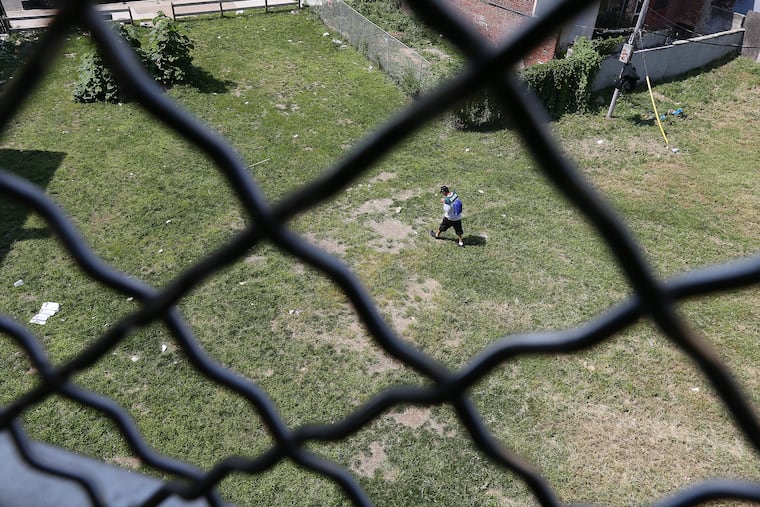The lonely search for Philly’s unidentified overdose victims | Mike Newall
The number of unidentified dead show isolating the opioid crisis can be.

A man who could have been anywhere between 20 and 50, with a fresh haircut and a pair of tattoos on his arms: "Hope" and "Faith." His body was discovered in a vacant lot off Lehigh Avenue, where he overdosed last year.
A man whose skeletonized remains were found in an abandoned Kensington rowhouse in September. A name — a clue — was scrawled on a gift certificate stuffed in his pocket, from a Bustleton tavern: "Jason." The certificate was from 2013.
A woman who was pushed from a truck on Frankford Avenue on a frigid December night, dragged, and then hit by another car. She died in the heart of the city's opioid epidemic, but her death, and her identity, remain a mystery.
They, and at least three other people, make up half of the cases listed on a public database that catalogs the city's recent unidentified dead.
Some victims, like the woman on Frankford Avenue, are linked to the opioid crisis only by where they died. Others are suspected to be overdose victims, too long dead for toxicology testing, but found with drug paraphernalia strewed around them. Some are found clean-shaven with expensive boots. Others are found with only the tattered remains of their clothing, or a hint of a tattoo.
>>READ MORE: The story of a shoeless John Doe, a forensic investigator and an Army tattoo | Mike Newall
A spokesperson for the medical examiner said the office is reluctant to tie the unidentified bodies directly to the crisis without more clues about how the people died, or to classify them as part of any larger trend. The vast majority of the city's 1,217 overdose victims last year were quickly identified.
Still, this small subgroup of unknown dead reminds us how quickly addiction can overtake people. By the time most victims make it to Kensington, the epicenter, they are usually far along enough in their addiction that they've had contact with police. Or are part of a community of drug users who look out for each other and can help investigators identify their friends.
The nameless show how isolating addiction can be. They may remain unidentified because they were estranged from their families. Or their families, knowing the pull of the drug, may be used to not hearing from them for months on end. Or their loved ones may be searching for them, but in the wrong places.
These dead are remarkable for how long they've been warehoused in obscurity. Their cases show the challenge of connecting the missing and the dead as the epidemic spirals.
"In this crisis, you see tragedy layered upon tragedy," said Thomas Farley, Philadelphia's health commissioner. "It is a different kind of tragedy when someone dies and no one knows about it."
>>READ MORE: 70 deaths in 30 days — Stories from a record-breaking year of loss.
At the Medical Examiner's Office, the cases fall into the hands of forensic investigators. To find families, investigators take advantage of new technology — facial recognition, forensic anthropology techniques, and even Facebook searches. They rely on old-fashioned shoe leather, too — consulting dental records and pacing the streets of Kensington, photos in hand.
I've grown familiar with their work over the course of the last year. They take extraordinary steps to find families. In one of last year's cases, a man was found at Somerset Street with an unusual tattoo of flowers blooming from a skateboard. One of the morgue's investigators stopped by skateboard shops and handed out fliers at FDR Park. For the man found with the gift certificate in his pocket, they called the bar and sent over a photo of the card — albeit fruitlessly. For a man found in North Philadelphia, behind an old sign factory, they are scouring phone records from his only possession, a mangled cellphone.
The public database, NAMUS, which catalogs unidentified and missing persons, has been championed by city investigators as a way for police and coroners, departments large and small, to help each other identify the unknown. Departments enter information — and even photos — voluntarily. There's a campaign to make it mandatory, nationwide.
Investigators hope the database can become a public resource for families.
But sometimes, it can be a compendium of tantalizing hints about the lives lost in Kensington. Like the woman on Frankford Avenue — so small, at 5 feet and 83 pounds — but with indications that she had once lived a life of means: A cosmetic chin implant. Pricey veneers on her teeth.
Or the man with a gold nose ring and pristine work boots, the sturdy ones that a construction worker might buy.
On Wednesday night, police received another phone call — the badly decomposed body of a man was found in a vacant lot near St. Joseph's Preparatory School. The ground was littered with syringes. There was no ID on the body, no fingerprint hit, no one to say who he was. Another unidentified dead from the crisis.